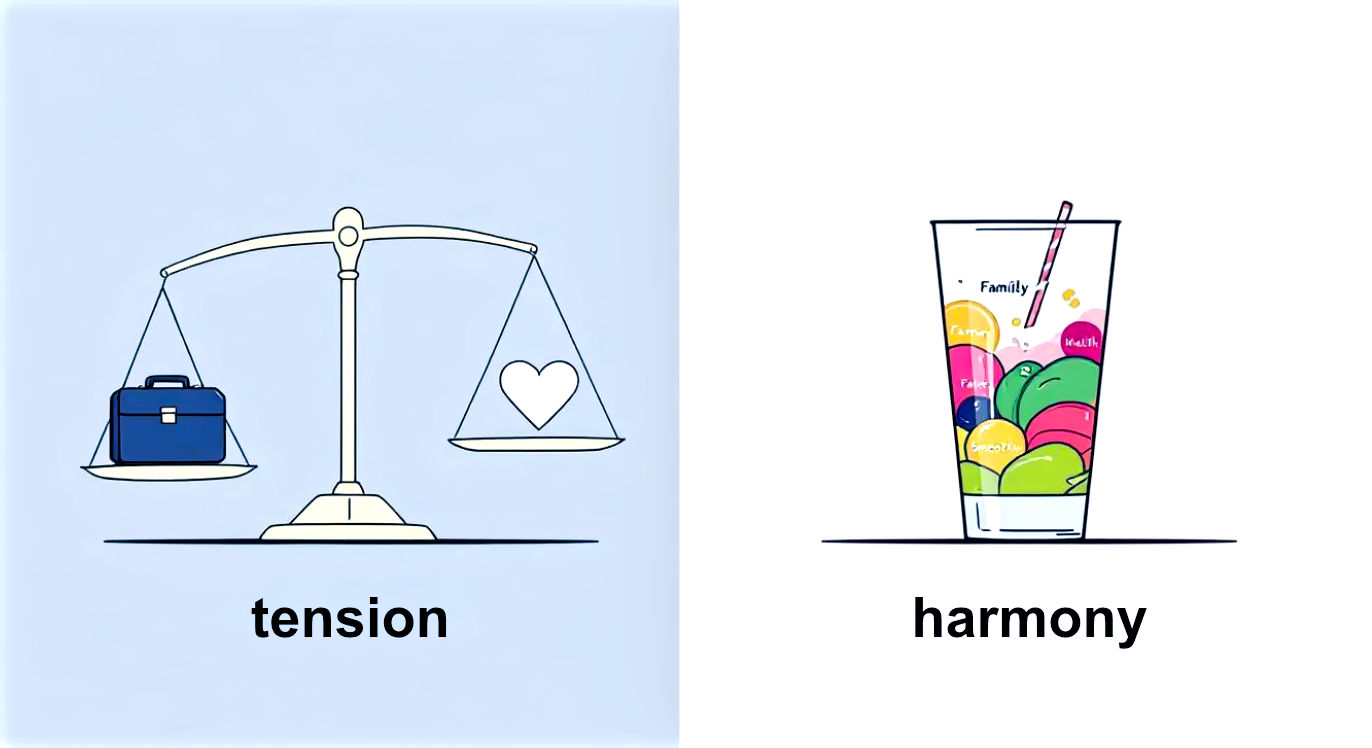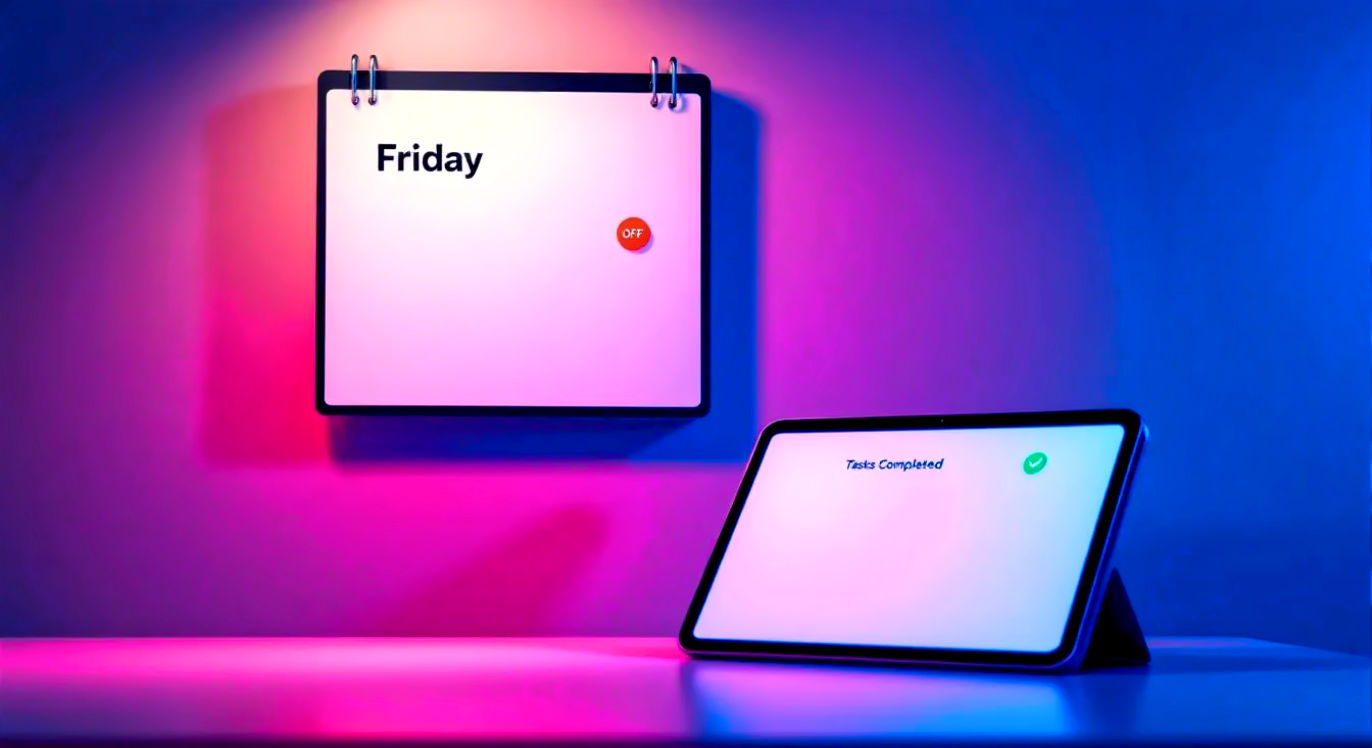The 7 Work-Life Integration Strategies That Actually Reduce Stress: A Complete Guide
Stop trying to “balance” work and life—it’s a recipe for stress. This definitive guide explores 7 real work-life integration strategies to help you regain control.

This post may contain affiliate links. If you make a purchase through these links, we may earn a commission at no additional cost to you.
Let’s be honest. The idea of “work-life balance” is a beautiful lie.
We were all sold a myth. It’s the image of a perfectly balanced scale. On one side, a shiny briefcase. On the other, a happy family and a yoga mat. At 5 PM, you’re supposed to step off the “work” side, and all its weight vanishes. Then you step onto the “life” side, perfectly present and stress-free.
It’s nonsense. And if you’ve ever felt like a failure for checking email at 7 PM, or for thinking about a grocery list during a meeting, you know why. You’re not failing at “balance.” The model itself is broken.
In our world, the boundaries are gone. Your phone, which holds your family photos, is also your office. Your kitchen table is your desk. Your team might be in three different time zones. Trying to build a rigid wall between “work” and “life” isn’t just hard; it’s a recipe for constant stress. You end up feeling guilty all the time—guilty for not working “enough,” and guilty for not being “present” enough at home.
It’s time to stop trying to balance two separate lives. It’s time to start integrating one whole one.
This is the definitive guide to work-life integration. This isn’t a theory; it’s a practical set of strategies for how to blend work and life together in a way that actually reduces your stress, gives you back control, and helps you build a life that feels like yours—not one that’s split in two.
What is Work-Life Integration (And What It’s Not)
Before we get to the strategies, let’s get one thing straight.

Work-life integration is NOT about working 24/7. It’s not about letting your boss text you at midnight. It’s not about being “always on.” In fact, it’s the exact opposite.
It’s about flexibility, control, and choice.
The Big Difference: The Scale vs. The Smoothie
Here’s the easiest way to think about it.
- Work-Life Balance is a scale. It’s a competition. For one side to go up, the other must go down. It’s a zero-sum game. If you’re winning at work, you’re losing at life. If you’re “present” at home, you’re “falling behind” at work. This creates constant tension.
- Work-Life Integration is a smoothie. Your life is one container. “Work” is an ingredient, like spinach. “Family” is an ingredient, like blueberries. “Health” is an ingredient, like protein powder. “Hobbies” are an ingredient, like a banana. The goal isn’t to taste just the spinach or just the banana. The goal is to blend them all together to create one thing that’s healthy, sustainable, and makes you feel good.
Sometimes you’ll add more spinach. Sometimes you’ll need more blueberries. But it’s all part of the same drink.
The Real Goal: A Life That Flows
Work-life integration is about erasing the hard, stressful lines and creating a flexible flow.
- It means you can stop a work project at 3 PM to pick up your kids from school, without feeling guilty.
- It means you can go to that 10 AM doctor’s appointment, without feeling stressed.
- It might also mean you spend an hour on a Sunday night planning your week, because it makes your Monday 10x less stressful.
The goal isn’t to work more. The goal is to stress less. It’s about designing a single, whole life where all the important pieces fit together, instead of fighting each other.
Before You Start: The 3-Step “Integration Audit”
You can’t build a new system until you know what you’re working with. Before you try any of the strategies below, you need to do a quick 3-step audit. This is the foundation.
Step 1: Identify Your “Non-Negotiables” (Life)
What matters most to you? These are the big rocks you have to put in the jar first. If you don’t, the sand and pebbles will fill it up, and you’ll never fit them in.
Your “non-negotiables” are the things you will not sacrifice. Be brutally honest.
- Is it being at the dinner table with your family every night at 6 PM?
- Is it your 7 AM morning run?
- Is it coaching your kid’s soccer team on Tuesdays?
- Is it turning your phone completely off from 8 PM to 8 AM?
Write these down. This is your “life” anchor. Integration does not mean sacrificing these things; it means building around them.
Step 2: Identify Your “Peak Performance” Times (Work)
When are you at your best? Not “when are you at your desk,” but when is your brain truly on?
- Are you a “morning lark” who can do deep, focused work from 6 AM to 9 AM?
- Are you a “night owl” who gets a second wind from 8 PM to 10 PM?
- When do you just drag? (That 2:30 PM slump is real for most people).
Be honest. The 9-to-5 model assumes everyone is a robot who is equally productive at 9:05 AM and 4:55 PM. That’s a joke. Find your “flow” times. This is your “work” anchor.
Step 3: Talk to Your Manager (The Right Way)
This is the scary part for many. But integration cannot happen in a vacuum. It requires communication.
Don’t go to your boss and say, “I want to try work-life integration.” That’s vague and sounds like you want to work less. Do go to your boss with a plan. Frame it as a way to be more productive and focused.
Here’s a script:
“I’m working on a plan to structure my day to be more focused and productive. I’ve found that I do my best, deepest work (like [Your Main Task]) first thing in the morning.
I’d like to try shifting my schedule: I’ll start at 8 AM and work with zero distractions until 11 AM. I need to step away from 3 PM to 4 PM for [Your Non-Negotiable, e.g., “a family commitment”]. I’ll be back online after that to finish my day and make sure the team has everything they need.
This will help me produce [Better Result, e.g., ‘get those reports done with fewer errors’] and I’ll still be fully available for all team meetings. Can we try this for two weeks and see how it works?”
See the difference? You’re not asking for a favor. You’re proposing a better way to work.
Now, let’s get to the 7 strategies.
Strategy 1: Build “Flexible Fences,” Not Rigid Walls
The “work-life balance” myth tells you to build a rigid brick wall. At 5 PM, you’re supposed to clock out, and that’s that.

The Problem: Life doesn’t care about your wall. Your kid gets sick at 10 AM. Your biggest client has an emergency at 6 PM. A great idea strikes you in the shower. When life inevitably does breach the wall, you feel like a total failure. Your stress goes through the roof.
The Integration Strategy: Stop building walls. Start building “flexible fences.”
A fence has a gate. You, the owner, decide when to open it and when to close it. This puts you in control.
How “Fences” Work: Core Hours vs. Flexible Time
This is the most popular way to build a fence. You divide your day into two types of time:
- Core Hours (e.g., 10 AM – 2 PM): This is your “fence-closed” time. During these hours, you are 100% “at work.” You’re available for meetings, you answer Slack/Teams messages, and you collaborate with your team. Everyone knows you are “on.”
- Flexible Time (e.g., 7-10 AM and 2-5 PM): This is your “fence-open” time. You still have to get your work done, but when and how you do it is up to you. You use this time for deep, focused work (like writing a report) or for “life” things (like going to the gym).
Example in Action: The 3 PM School Pickup
Let’s say your “non-negotiable” is picking up your kids from school at 3 PM.
- The “Balance” (Wall) Approach: You feel stressed all day, watching the clock. You rush out at 2:50 PM, feeling guilty. You miss a 3:30 PM meeting. Your boss is annoyed. You feel like you’re failing at work and life.
- The “Integration” (Fence) Approach: Your team knows your core hours are 9 AM-2:30 PM. You are the most present, productive employee during that time. At 2:30 PM, you sign off for your “life” block. You pick up your kids, help with homework, and have quality time. You’re 100% present as a parent. Then, maybe at 8 PM, after the kids are in bed, you open the “fence” again. You spend 45 minutes prepping for your morning meeting and clearing your inbox. You go to bed feeling peaceful, prepared, and in control.
How This Reduces Stress: It removes the guilt. You’re not “sneaking out” of work. You’re not “failing” at home. You are simply moving your blocks of time around to fit your life. You’re managing expectations.
Strategy 2: Master “Task Batching” and “Time Blocking”
Integration can get messy if you don’t have a system. If you’re trying to write a report while answering emails while helping your kid with math, you’re not integrating. You’re just… exploding.
The Problem: Your brain hates multitasking. Scientists call it “context switching.” Every time you switch from one task to another (from a spreadsheet to an email to a text message), your brain pays a “tax.” It takes time and energy to re-focus. Doing this all day is why you feel exhausted by 5 PM, even if you “didn’t do much.”
The Integration Strategy: You “integrate” by separating. You create specific blocks for specific types of work. This is a one-two punch: “Time Blocking” and “Task Batching.”
How to “Time Block” Your Day (A 4-Step Guide)
Time blocking is simple: You give every minute of your day a job. You look at your to-do list, then you pull out your calendar. Instead of a list of things to do, you create a plan for when to do them.
- Block Your “Non-Negotiables” First: Put your “life” anchors from the audit (gym, family dinner, kids’ pickup) on the calendar. These are sacred.
- Block Your “Deep Work” Next: Look at your “peak performance” times. Block 1-2 hours of uninterrupted time for your most important, brain-heavy task. Label it: “DEEP WORK: Project X.”
- Block Your “Shallow Work”: Find 1-2 smaller blocks for the “easy” stuff—answering emails, filling out forms, scheduling.
- Block Your “Life” Stuff: Yes, schedule lunch. Schedule “Walk the dog.” Schedule a 15-minute “coffee break.”
Your calendar is now a perfect map of your integrated day.
The Magic of “Task Batching”
Now, you make your time blocks powerful by batching similar tasks together.
- Don’t check email 40 times a day. Create an “Email Batch” block. Maybe it’s 30 minutes at 10 AM and 30 minutes at 4 PM. Outside of those times, your email is closed.
- Don’t make one phone call now and one later. Create a “Calls Batch.”
- Don’t run one errand at 11 AM and another at 4 PM. Create an “Errands Batch.”
Real-World Scenario: The Remote Worker’s Day
- 7:00-7:45 AM: Life (Workout / Meditate)
- 7:45-8:30 AM: Life (Get kids ready, breakfast)
- 8:30-9:00 AM: Work (Shallow Batch: Plan day, check email)
- 9:00-11:00 AM: Work (Deep Block: “Project Phoenix”)
- 11:00-11:45 AM: Life (Walk dog, start laundry, make lunch)
- 11:45-12:30 PM: Life (Eat lunch away from desk)
- 12:30-2:30 PM: Work (Core Hours: Team meetings, calls)
- 2:30-3:00 PM: Work (Shallow Batch: Answer emails, Slack)
- 3:00-4:00 PM: Life (Kids home, snack time)
- 4:00-5:00 PM: Work (Deep Block: “Finish presentation”)
How This Reduces Stress: It completely eliminates the “what should I be doing right now?” panic. You just look at your calendar. It removes the decision fatigue and gives you permission to be 100% focused on one thing at a time.
Strategy 3: “Pull” Life Into Your Workday (On Purpose)
This is where integration starts to feel really good.

The Problem: The old “balance” model says you have to be a “Work-Bot” from 9-to-5. You’re supposed to sit at your desk, chain yourself there, and pretend you don’t have a body, a family, or a home. This is why you feel burned out. You’re ignoring your human needs for 8 hours straight.
The Integration Strategy: Stop feeling guilty for being a human. Intentionally pull “life” into your workday in small, planned doses.
This isn’t about slacking off. It’s about recharging so you can be more focused when you are working. These are your “micro-doses” of life.
What This Looks Like:
- The 20-Minute Workout: In your 11 AM “flex” time, do a quick HIIT workout or a yoga flow. You’ll come back to your desk with more energy and clarity than you would have from “pushing through.”
- The 1-Hour Real Lunch: Don’t eat a sad salad at your desk. Schedule an hour. Go outside. Meet a friend. Read a book. Cook a real meal.
- The 10-Minute Meditation: Feeling overwhelmed at 2 PM? Don’t just gulp more coffee. Step away, use a meditation app for 10 minutes, and reset your nervous system.
- The “Errand” Break: Take 45 minutes at 2 PM to go to the post office or pick up groceries when the store is empty. It’s dramatically less stressful than trying to do it at 5:30 PM with the rest of the world.
Why This Boosts Productivity (The Science)
Your brain can only really focus for about 90 minutes at a time. After that, its performance plummets. The “Pomodoro Technique” (25 min work, 5 min break) is famous for a reason.
By integrating these “life” breaks, you are honoring your brain’s natural rhythm. You’re not “slacking”; you’re managing your energy. You’ll get more done in two 90-minute focused blocks (with a real break in between) than you will in three hours of “half-working” drudgery.
How This Reduces Stress: It stops the buildup of burnout. It gives you small “wins” and moments of peace throughout the day. It makes your workday feel like your day, not just the company’s.
Strategy 4: “Push” Work Into Your Life (Carefully and Consciously)
This is the most misunderstood—and most powerful—strategy of all.
The Problem: The “balance” model creates a “Sunday Scaries” monster. Because you’ve built a “wall,” Monday morning feels like a tidal wave. You spend all of Sunday dreading the 500 emails, the surprise meetings, and the chaos.
The Integration Strategy: You consciously choose to “push” a small, controlled amount of work into your “life” time… if it makes your life less stressful.
This sounds like a trap. But it’s not. Remember, this is about control vs. compulsion.
- Compulsion (Bad): You’re at your kid’s soccer game, but you can’t stop checking your email. You’re addicted. You’re anxious. Your boss expects it. This is not integration. This is burnout.
- Control (Good): It’s 8 PM on Sunday. Your kids are in bed. You choose to open your laptop for 20 minutes. You delete the junk, sort your inbox, and make a 3-point to-do list for Monday. You close the laptop and go to bed feeling prepared, calm, and in control.
When Is This a Good Idea?
- To beat the “Sunday Scaries” (like the example above).
- To end a “work block” early. Maybe you want to log off at 4 PM on the dot on Friday for a weekend trip. You might choose to check in for 15 minutes on Saturday morning just to make sure no fires started, giving you peace of mind to truly enjoy the rest of your weekend.
- To capture a brilliant idea. You’re walking your dog at 8 PM and a genius solution to a work problem hits you. Don’t let it circle in your head, ruining your walk. Take 2 minutes. Send yourself a detailed voice memo or email. Get it out of your head. Then, you’re free to enjoy your walk.
How This Reduces Stress: This strategy is about lowering your overall “anxiety load.” The 20 minutes of “work” on Sunday night is a tiny price to pay for 24 hours of anxiety-free living (all of Sunday and Monday morning).
This is the peak of integration. You’re no longer seeing “work” and “life” as enemies. You’re using one to make the other better.
Strategy 5: Use Technology as a Tool, Not a Tyrant
Your phone is the main reason work-life “balance” is dead. But it can also be your single greatest integration tool. Right now, it’s probably your boss. You need to make it your assistant.

The Problem: Every ping, buzz, and badge is a tiny little stress spike. It’s a demand for your attention right now. This destroys your focus, trains your brain to be reactive, and keeps you in a constant state of low-grade anxiety.
The Integration Strategy: You must ruthlessly take back control of your technology. Your tools should serve you, not the other way around.
The 3-Click Guide to Taming Notifications
Do this. Right now.
- Turn Off ALL Notifications (Except for Humans): Go into your phone’s settings.
- Email App? Notifications OFF.
- Slack/Teams? Notifications OFF (or set to “DMs and Mentions Only”).
- Social Media? OFF. OFF. OFF.
- News Apps? OFF.
- The only apps that should be allowed to interrupt you are “human” apps—like your Phone and your Messages/WhatsApp (and even then, you can mute group chats).
- This is critical: You now check these apps on your schedule (see Strategy 2: Task Batching), not on their schedule.
- Clean Your Home Screen: Your home screen is a minefield of stress. Move every “work” app (and social media app) off the main screen and into a folder on the second page. Make it harder to “just check.”
Use “Focus Modes” and “Do Not Disturb” (And Tell People)
Your phone (and computer) has “Focus Modes.” Use them.
- Create a “Deep Work” mode that blocks everything except your work apps.
- Create a “Personal” mode that blocks everything related to work.
- Create a “Sleep” mode that blocks everything (except for emergency calls from favorites).
And then… tell people. Put it in your email signature: “I check email twice a day, at 10 AM and 4 PM, to stay focused. If your matter is urgent, please call.” This sets expectations and gives you the freedom to not respond instantly.
How This Reduces Stress: You are moving from a reactive life (a victim of pings) to a proactive life (the boss of your own attention). This is maybe the single biggest stress-reducer on this entire list.
Strategy 6: Embrace Asynchronous Communication
This is a strategy for teams, but you can lead the charge.
The Problem: We live in an “always-on,” “I need an answer NOW” culture. We use “instant” message tools (like Slack) for non-instant things. This means everyone is constantly interrupting everyone else. A simple question can derail an entire hour of deep work.
The Integration Strategy: Champion “asynchronous” (or “async”) communication.
“Async” simply means: “I am sending you this message without the expectation that you will reply immediately. Please reply when it works for you.”
This is how email was supposed to work.
How to Do It:
- Lead by Example: When you send a non-urgent email or Slack message, add a line: “No rush on this, just need your thoughts by end of day tomorrow.” Or, “FYI for when you’re back—no action needed.”
- Use the Right Tool:
- Is it a complex idea? Send a recording. Use a tool like Loom to record your screen and voice. This lets your co-worker “attend your meeting” on their schedule.
- Is it a general update? Write a clear document or project update and post it. Don’t call a meeting.
- Is it truly urgent? Pick up the phone. That’s what it’s for.
- Default to “Async”: Assume the other person is in a “Deep Work” block. Your default should be not to interrupt.
How This Reduces Stress: Async work is the key to true flexibility. It allows a team member to go to a 2 PM doctor’s appointment without 15 “WHERE ARE YOU” messages. It lets people work at their own peak performance times. It breaks the “instant reply” anxiety cycle for everyone.
Strategy 7: Schedule “Do-Nothing” Time (The Integration of “Self”)
This is the last and most important strategy. In your rush to integrate “work” and “life,” it’s easy to forget to integrate you.

The Problem: We are obsessed with productivity. We try to “optimize” our “life” time just as much as our “work” time. We have “productive” hobbies, we “optimize” our weekends, and we “hustle.” This leads to a new kind of burnout, where even “fun” feels like a job.
The Integration Strategy: You must schedule “white space” on your calendar. This is time with no plan. It is “Do-Nothing” time.
This isn’t “meditation” time or “workout” time. This is “stare at the wall” time. “Doodle on a notepad” time. “Lay in the grass” time.
Why This Is Your Secret Weapon
- It’s “Buffer Time”: Life is unpredictable. Your meeting will run over. You will hit traffic. If your schedule is blocked back-to-back, you are living in a state of constant “running behind.” White space acts as a buffer. It absorbs the chaos, so one late meeting doesn’t blow up your whole day.
- It’s “Recovery Time”: Your brain needs to be bored. This is when it processes information, connects ideas, and solves background problems. Your best ideas almost never come when you’re staring at a spreadsheet. They come in the shower, on a walk, or when you’re “spacing out.”
How to Schedule It
- Look at your calendar. Find 15-20 minute gaps between meetings or blocks.
- Create a recurring event. Call it “BUFFER” or “WHITE SPACE.”
- Treat it with the same respect as a meeting with your CEO. Do not book over it.
- When the time comes, do nothing. Resist the urge to “just check email.” Stand up. Get water. Look out the window. That’s it.
How This Reduces Stress: This is the pressure release valve. It stops your entire day from boiling over. It gives you the one thing “hustle culture” took away: permission to just be.
Common Traps: How Work-Life Integration Fails
Even with these strategies, it’s easy to fall into old traps. Watch out for these.
- Trap 1: The “Always On” Guilt.
- What it looks like: You’ve adopted “flexibility,” but you feel guilty for using it. You’re at your kid’s 3 PM game, but you’re compulsively checking Slack to “prove” you’re still working.
- How to fix it: Re-read Strategy 5 and 6. Communicate your “fences.” Set your Slack status to “At kids’ game – back at 4:30.” You have to own your schedule, not apologize for it.
- Trap 2: Lack of Communication (With Family and Team).
- What it looks like: You’re using Strategy 4 and clearing your inbox at 8 PM, but your partner is getting upset. Or, you’ve started “time blocking,” but your team just thinks you’re “ignoring” them.
- How to fix it: You must over-communicate. Tell your family: “I’m going to spend 20 minutes on this so that I can be 100% present for our movie.” Tell your team: “I’ll be in deep focus mode from 9-11 AM. I’ll respond to all messages after that.”
- Trap 3: Forgetting Your “Non-Negotiables.”
- What it looks like: A “flexible” schedule slowly turns into “work all the time.” You haven’t been to the gym in three weeks, and you’ve missed family dinner every night.
- How to fix it: Go back to your Step 1 Audit. Put your non-negotiables on your calendar first. Make them recurring events. Protect them more fiercely than your work meetings.
The Future of Integration: AI and the 4-Day Week
This isn’t just a personal trend; it’s the future of work. Companies are realizing that “hours at a desk” is a terrible way to measure performance.
- Focus on “Output,” Not “Hours”: The 4-day work week is a perfect example of integration. Companies are finding they can get the same (or better) results in 32 focused hours as they did in 40+ distracted ones.
- AI as Your Assistant: Soon, AI won’t just be a tool. It will be your integration partner. It will schedule your day based on your non-negotiables, your energy levels, and your team’s needs. It will handle the “shallow” work, leaving you only the deep, human parts.
Conclusion: Your Life is a Single, Integrated Whole
The single biggest cause of work-life stress is the feeling of being in conflict with yourself. It’s the war between “Employee-You” and “Parent-You” or “Spouse-You.”
Work-life integration ends that war.
It’s a mindset shift. It’s the understanding that you only have one life. It is a single, integrated whole. Your work can enrich your life (by giving it meaning and resources), and your life can enrich your work (by giving you energy, perspective, and rest).
The goal is not a “perfect,” color-coded calendar. The goal is peace. It’s to end your day feeling used, but not used up. It’s to be able to look at your work, your family, your health, and your passions and see that they are all “ingredients” in a life that you chose and designed for yourself.
Your next step is simple: Don’t try all 7 strategies tomorrow. Pick one. Maybe you’ll just do the “3-Step Audit.” Or maybe you’ll just turn off your email notifications. Start there. The “balance” is a myth, but a calmer, more controlled, and integrated life is 100% within your reach.
Further Reading
- Harvard Business Review (HBR): Work, Life, and the Grinding 24/7 Juggling Act – HBR has extensive research and articles on the shift from “balance” to “integration.”
- Forbes: Why Work-Life Integration Is The New ‘Balance’ – Great articles from a leadership and career perspective.
- SHRM (Society for Human Resource Management): Managing Workplace Flexibility – An excellent resource for understanding how companies are officially handling these new work models.
- Psychology Today: The Truth About Burnout – Understand the why behind your stress and the psychological benefits of setting boundaries.
- Cal Newport’s “Deep Work”: While not a website, this book is the unofficial bible for Strategies 2, 5, and 6. It provides the “how-to” for focused work in a distracted world.
